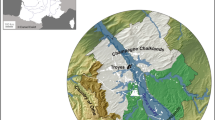Abstract
Medieval crops are depicted in illuminated manuscripts, mentioned in medieval texts and found in excavations. Only texts and archaeobotanical finds provide names. Both sources suffer from their own biases and a comparison shows that they need not agree. The seeds and fruits retrieved during excavations reveal that soil is an important factor. Crops raised on sandy soils differ from those on loess soils, at least in the area under discussion: the northern part of the realm of the Franks. The kind of government seems to have been less important. There is almost no difference between the Merovingian-Carolingian period and the following period of less central power. During the entire period under review a free three-course crop rotation is assumed to have prevailed.


Similar content being viewed by others
References
Bakels, C.C. (1999). Dury “Le Moulin”(Somme), étude des restes botaniques. Revue archéologique de Picardie, 1–2, 237–245
Bakels, C.C. (2002). Zaden en vruchten uit grondsporen uit de Vroege en de volle middeleeuwen [seeds and fruits from early and high medieval features]. In: Ball, E.A.G., Jansen, R. (eds) Van steentijd tot middeleeuwen: archeologisch onderzoek rond een fossiele beekloop te Herpen-Wilgendaal [from stone age to middle ages; archaeological investigations around a small fossil valley at Herpen-Wilgendaal]. Vol. 11. ARCHOL Rapport, Leiden, 200–201
Bakels, C.C. (2003). Botanisch onderzoek [botanical investigations]. In: Arnoldussen, S. (ed) Middeleeuwse bewoning te Bakel-Achter de Molen (Brabant)[medieval occupation at Bakel-Achter de Molen (Brabant)]. Vol. 16. ARCHOL Rapport, Leiden, 109–112
Bakels, C.C., Dijkman, W. (2000). Maastricht in the first millennium AD, the archeobotanical evidence. Archaeologica Mosana, 2
van Beurden, L. (2002). Botanisch onderzoek in het Maas-Demer-Schelde gebied [botanical research in the Maas-Demer-Schelde area]. In: Fokkens, H., Jansen, R. (eds) 2000 jaar bewoningsdynamiek [2000 years of occupational dynamics]. Faculteit der Archeologie, Leiden, pp 287–314
Blockmans, W., Hoppenbrouwers, P. (2002). Eeuwen des Onderscheids, een geschiedenis van middeleeuws Europa [Centuries of Discretion, a history of the Middle Ages]. Prometheus, Amsterdam
Brevium Exempla (no year). Source text in: Monumenta Germaniae Historica. Deutsches Archiv
Gareis, K. (1895). Die Landgüterordnung Kaiser Karls der Grossen (Capitulare de villis vel curtis imperii). Guttetag, Berlin
Green, F.J. (1984). The archaeological and documentary evidence for plants from the medieval period in England. In: van Zeist, W., Casparie, W.A. (eds) Plants and ancient man. Balkema, Rotterdam, pp 99–114
Grierson, P. (1939). The identity of the unnamed fiscs in the Brevium exempla ad describendas res ecclesiasticas et fiscales. Revue belge de philologie et d’histoire, 18, 437–461
de Hingh, A., Bakels, C. (1996). Palaeobotanical evidence for social difference? The example of the early medieval domain of Serris-les-Ruelles. Vegetation History and Archaeobotany, 5, 1–11
Irniger, M., Kühn, M. (1999). Obstvielfalt – von wilden und zahmen Früchten im Mittelalter und in früher Neuzeit. Archäologie der Schweiz, 22/1, 49–56
Karg, S., Jacomet, S. (1991). Pflanzliche Makroreste als Informationsquellen zur Ernährungsgeschichte des Mittelalters in der Schweiz und Süddeutschland mit besonders Berücksichtigung der Verhältnisse in der Schweiz. In: Tauber, J. (ed) Methoden und Perspektiven der Archäologie des Mittelalters, Amt für Museen und Archäologie, Liestal/Schweiz, pp 121–143
Pals, J.P. (1988). Phyto-Archeologische Studies [Phytoarchaeological Studies]. Thesis Amsterdam
Ruas, M.P. (1988). Agriculture. In: Un village au temps de Charlemagne. Éditions de musées nationaux, Paris, pp 203–213
Slicher van Bath, B.H. (1963). The agrarian history of western Europe. Arnold, London
Theuws, F., Roymans, N. (1999). Long-term perspectives on land and people in the Meuse-Demer-Scheldt region (1100 BC–1500 AD). In: Land and ancestors. Amsterdam University Press, Amsterdam, pp 1–24
Willerding, U. (1984). Paläo-ethnobotanische Befunde und schriftliche sowie ikonographische Zeugnisse in Zentraleuropa. In: van Zeist, W., Casparie, W.A. (eds) Plants and ancient man, Balkema, Rotterdam, pp. 75–98
van Zeist, W., Woldring, H., Neef, R. (1994) Plant husbandry and vegetation of early medieval Douai, northern France. Vegetation History and Archaeobotany, 3, 191–218
Acknowledgements
I thank the colleagues from the University of Groningen, and especially H. Woldring, for giving me access to some unpublished material from Douai
Author information
Authors and Affiliations
Corresponding author
Rights and permissions
About this article
Cite this article
Bakels, C.C. Crops produced in the southern Netherlands and northern France during the early medieval period: a comparison. Veget Hist Archaeobot 14, 394–399 (2005). https://doi.org/10.1007/s00334-005-0067-x
Received:
Accepted:
Published:
Issue Date:
DOI: https://doi.org/10.1007/s00334-005-0067-x




